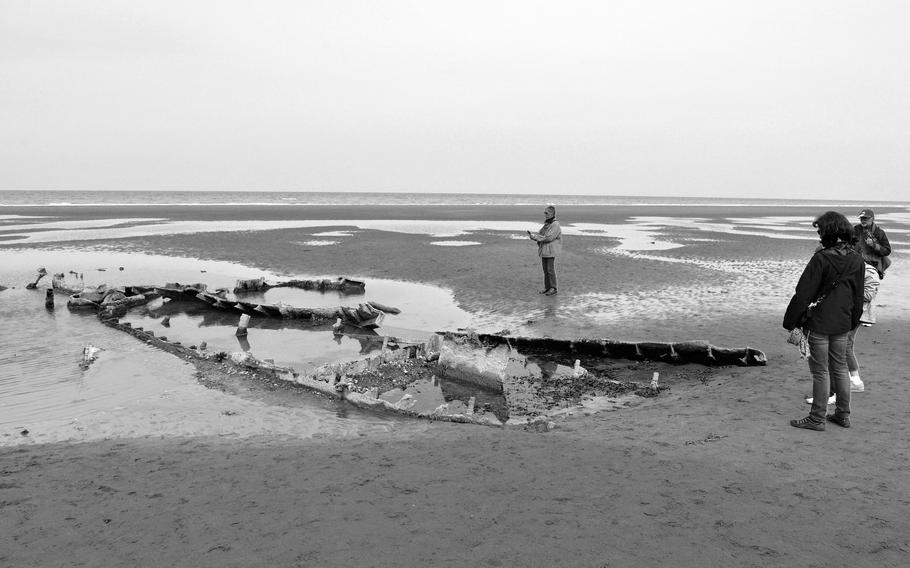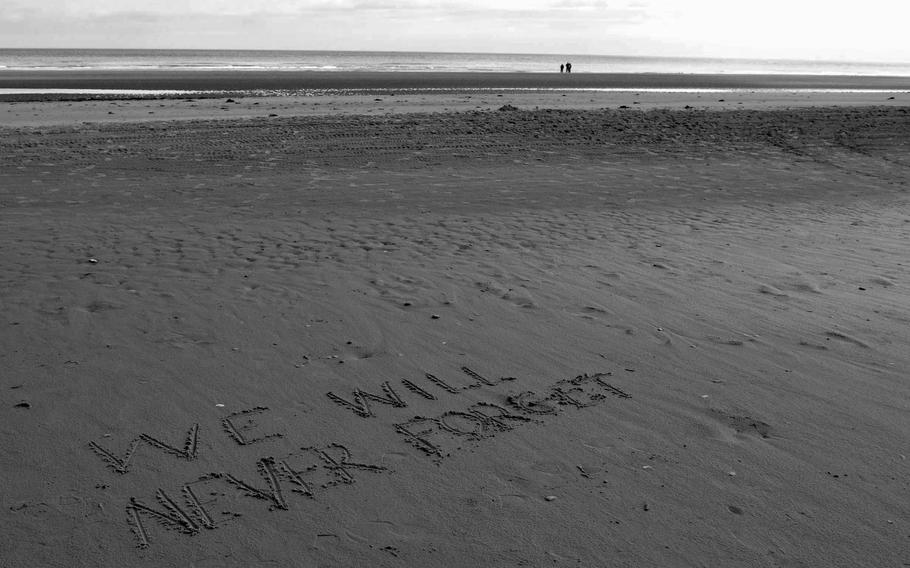
Visitors look at the remains of a world War II landing craft sunk in the sands of Omaha Beach below the Normandy American Cemetery in April 2014. (Michael Abrams/Stars and Stripes)
This month of the 80th Anniversary of D-Day, Stars and Stripes is republishing a number of articles as reported by its staff writers at the time. Jack Foster witnessed what would become D-Day’s bloodiest landing from aboard the USS Henrico – the ship that carried troops of the US Army’s 1st Infantry Division to Omaha Beach. This article first appeared in the Stars and Stripes London edition June 8, 1944. It is republished unedited in its original form.
ABOARD THE USS HENRICO OFF THE FRENCH COAT, June 6 (delayed) — Naval guns and army rifles combined today to win one of the toughest beachheads the Allied forces have established on the Normandy coast during the past 12 hours.
U.S. infantrymen, who left this assault transport before dawn this morning, met determined resistance by German defenders. Pillboxes and landing obstacles guarded the landing area despite a drenching rain of bombs and naval shells.
The Americans crossed the sandy beach. However, by late this afternoon they gained the top of the coastal rise and were advancing inland. Going ashore in an LCVP a few hours ago, I could see long lines of doughboys climbing the slopes and only occasional long-range shells dropped along the beach.

Someone left the message "We will never forget" for the veterans of D-Day on Omaha Beach on the anniversary weekend of the 70th anniversary of D-Day in 2014. (Michael Abrams/Stars and Stripes)
Nazis Hold Fire
A landing was almost impossible at two of the three chosen points in our sector. When the first of our LCVPs ground ashore at 6.35 this morning it was H hour exactly. German gunners in concealed positions held their fire. At the third point landing obstacles jutted from the water. Barbed wire was enclosed in the visible V-shape. Mines dangled from the wire.
Wave after wave of the Americans came ashore, firing rifle and carbine. Nazi spotters on the ridge directed mortar and 88mm. fire to the attackers. Battleships, cruisers and destroyers moved slowly along the area crashing out salvos against the strongpoints.
Finally a U.S. destroyer came in almost to the water’s edge, swung about and blasted at the pillboxes. Her fire overpowered the Nazi guns and the advance began.
Barking army rifles killed off the enemy wherever he came into the open. In the center of the beach was a white house, frequently the target of warships’ guns. It was set afire and abandoned by German snipers.
Two small boat coxwains from this vessel told me they saw a German come out in front of the building and carefully aim his rifle in front of the entire invading force. “We cut him in half with our guns,” they said.
Some of the beach debris already has been cleared away. The wounded have been loaded onto small craft returning to the transports. Corpsmen aboard this ship have been bringing casualties, mostly of a minor nature, into her sick bay.
Flights of Allied bombers have been overhead all day, speeding unmolested to hammer positions inland. At times this morning the beach was so obscured by the smoke of the bombing and shelling that it could not be seen from our transport formation, 12 miles offshore.
Our troops never stopped coming, although the toll in lives was heavy at first. Already the first are inland at this point and those on the beach are eager to push on into ex-Fortress Europe.
Typical of these was the infantryman we took aboard our small craft after he had been hit by a shrapnel burst:
“If that doggone lieutenant had let me go on ahead and shoot some Germans instead of ordering me to fix a half-sunk jeep, I wouldn’t have been wounded,” he lamented. “Now I can’t fight anybody and I got to ride in one of these boats again.”
Find Stars and Stripes’ reports on the 80th Anniversary of D-day here and here.
https://www.stripes.com/special-reports/featured/d-day/
https://europe.stripes.com/d-day/
Looking for more of Stars and Stripes’ historic D-Day and World War II coverage? Subscribe to Stars and Stripes’ historic newspaper archive! We have digitized our 1948-1999 European and Pacific editions, as well as several of our WWII editions and made them available online through https://starsandstripes.newspaperarchive.com/